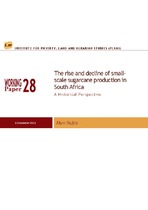| dc.description.abstract | South Africa’s sugar industry has long been distinguished by its large number of small-scale sugarcane
growers (SSGs) farming on ‘communal’ land and its peculiar, privately administered regulatory structure. In
recent years, however, the number of small-scale growers has declined precipitously from a peak of around
50 000 in the early 2000s to fewer than 14 000 in 2011, a trend attributed by many to the impacts of
drought. Over the same period, South Africa’s sugar milling companies have been investing heavily in
countries to the north, heralding substantial shifts in patterns of national and corporate production. As
Brazilian sugar imports begin to penetrate the domestic market, the industry’s organizing regulatory
framework is also set to change, after more than 10 years of confidential negotiation. A re-appraisal of the
structure of the industry, and in particular of the role of SSGs within it, is thus overdue.
This paper argues that the relationship between the rise and fall of small scale sugarcane production and
the industry’s governing regulatory structure is closer than usually appreciated. Critically, the emergence of
SSG production in the late 1970s to the early 1980s can be traced to industry-subsidised initiatives,
disguised as micro-credit, which brought commercially inalienable Bantustan land into cane production
under strong miller oversight. From the late 1980s to the early 1990s, however, the elimination of these
subsidies encouraged millers to withdraw from direct oversight and to subcontract farmer support, while
simultaneously instigating an increase in SSG numbers by removing restrictions on grower registration.
Enduring drought must certainly be understood as an important proximal factor in the rapid decline of
SSGs in the 2000s, but their rapid increase in the first place was structurally fragile. In particular, these
processes reflected SSGs shifting structural relationships to South African sugar milling and planting capital.
Understanding these changes thus requires locating them within a longer-term historical drama
characterised by crisis and competition, and driven by key contradictions of South African capitalism
during and after ‘late’ apartheid. | en_US |

